Spectral-Kurtosis and Image-Embedding Approach for Target Classification in Micro-Doppler Signatures
Abstract
1. Introduction
2. Micromotion Modeling
3. Spectral Kurtosis-Based Target Classification
3.1. Spectral Kurtosis
3.2. Feature Extraction Using an Embedding Function
4. Deep Neural Network Algorithm
5. Classification Experiments
5.1. Experimental Environments
5.2. Performance Evaluation Metrics
- TP (true positive): accurate classification of the category of interest
- TN (true negative): accurate classification of items not in the category of interest
- FP (false positive): misclassification of noninterest categories as interest categories
- FN (false negative): incorrect classification of a category of interest as not a category of interest.
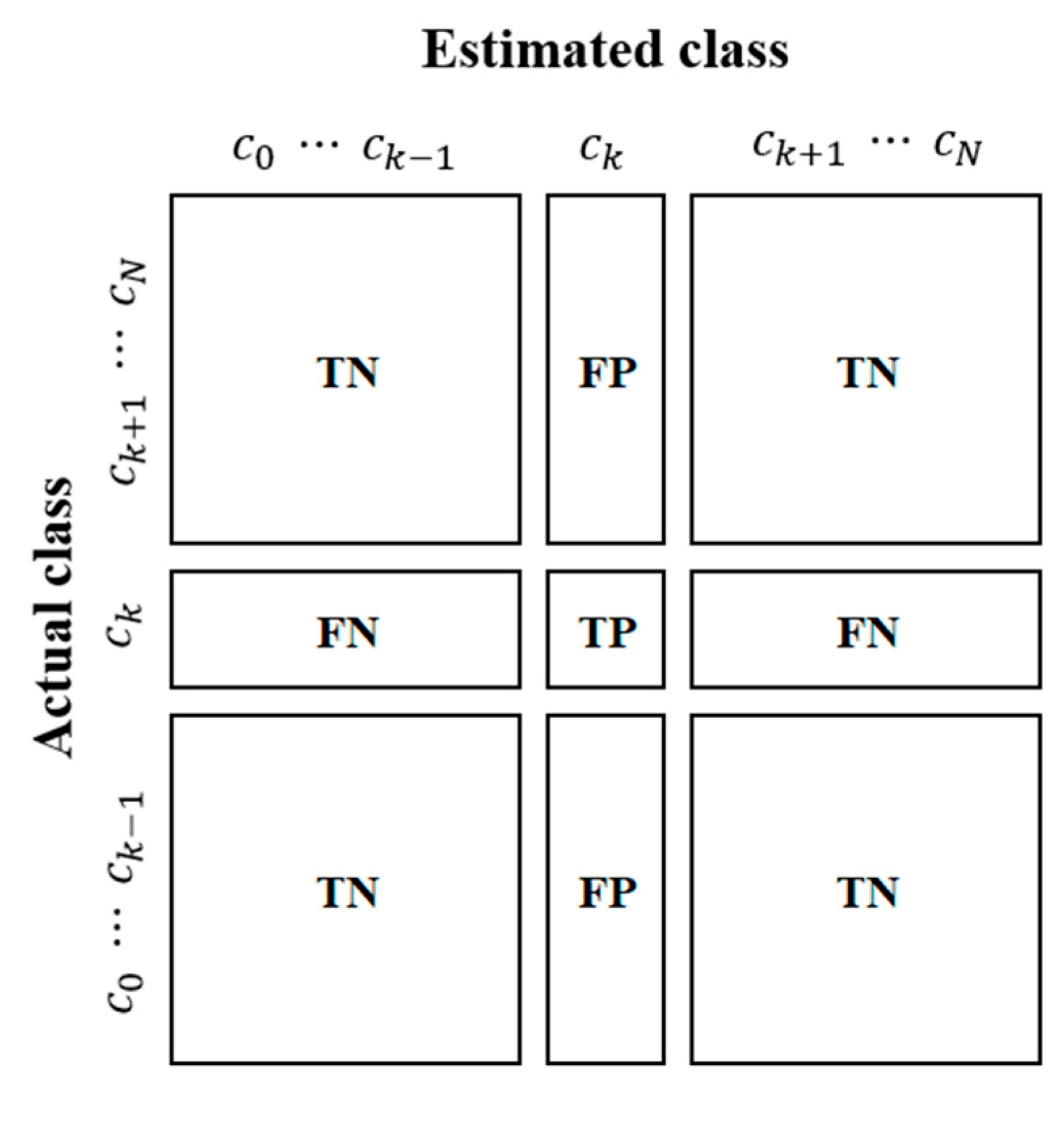
5.3. Classification Experiments
5.3.1. Experiment 1: Three-Class Classification of Different Micromotion Targets
5.3.2. Experiment 2: Five-Class Classification of Different and Same Micromotion Targets
5.3.3. Experiment 3: Three-Class Target Classification under Different SNR Scenarios
6. Conclusions
Author Contributions
Funding
Data Availability Statement
Conflicts of Interest
References
- Park, G.-H.; Kim, D.-G.; Kim, H.-J.; Park, J.-O.; Lee, W.-J.; Ko, J.H.; Kim, H.-N. Performance analysis of interference cancelation algorithms for an FM Based PCL system. J. Korean Inst. Commun. Inf. Sci. 2017, 42, 819–830. [Google Scholar]
- Choi, S.; Crouse, D.; Willett, P.; Zhou, S. Multistatic target tracking for passive radar in a DAB/DVB network: Initiation. IEEE Trans. Aerosp. Electron. Syst. 2015, 51, 2460–2469. [Google Scholar] [CrossRef]
- Colone, F.; Martelli, T.; Bongioanni, C.; Pastina, D.; Lombardo, P. Wifi-based PCL for monitoring private airfields. IEEE Trans. Aerosp. Electron. Syst. 2017, 32, 22–29. [Google Scholar] [CrossRef]
- Ma, H.; Antoniou, M.; Pastina, D.; Santi, F.; Pieralice, F.; Bucciarelli, M.; Cherniakov, M. Maritime moving target indication using GNSS-Based bistatic radar. IEEE Trans. Aerosp. Electron. Syst. 2018, 54, 115–130. [Google Scholar] [CrossRef]
- Chen, V. The Micro-Doppler Effect in Radar; Artech House: Norwood, MA, USA, 2011. [Google Scholar]
- Antoni, J. The Spectral Kurtosis: A Useful Tool for Characterising Non-Stationary Signals. Mech. Syst. Signal Process. 2006, 20, 282–307. [Google Scholar] [CrossRef]
- Ritchie, M.; Fioranelli, F.; Borrion, H.; Griffiths, H. Multistatic Micro-Doppler Radar Feature Extraction for Classification of Unloaded/Loaded Micro-Drones. IET Radar Sonar Navig. 2016, 11, 116–124. [Google Scholar] [CrossRef]
- Pallotta, L.; Clemente, C.; Raddi, A.; Giunta, G. A Feature-Based Approach for Loaded/Unloaded Drones Classification Exploiting micro-Doppler Signatures. In Proceedings of the 2020 IEEE Radar Conference (RadarConf20), Florence, Italy, 21–25 September 2020; pp. 1–6. [Google Scholar]
- Zhang, P.; Li, G.; Huo, C.; Yin, H. Exploitation of Multipath Micro-Doppler Signatures for Drone Classification. IET Radar Sonar Navig. 2020, 14, 586–592. [Google Scholar] [CrossRef]
- Cheng, W.; Shen, Y.; Huang, L.; Zhu, Y. A Dual-Embedding based Deep Latent Factor Model for Recommendation. In Proceedings of the IJCAI, Stockholm, Sweden, 13–19 July 2018; Volume 18, pp. 3329–3335. [Google Scholar]
- He, K.; Zhang, X.; Ren, S.; Sun, J. Deep residual learning for image recognition. In Proceedings of the 2016 IEEE CVPR, Las Vegas, NV, USA, 27–30 June 2016; pp. 770–778. [Google Scholar]
- Kim, J.-H.; Park, D.-H.; Kim, H.-N. Performance Analysis of ResNet-based Target Classifications using Spectral Kurtosis. J. Inst. Electron. Inf. Eng. 2022, 59, 99–106. [Google Scholar]
- Han, X.; Zhong, Y.; Cao, L.; Zhang, L. Pre-Trained AlexNet architecture with pyramid pooling and supervision for high spatial resolution remote sensing image scene classification. Remote Sens. 2017, 9, 848. [Google Scholar] [CrossRef]
- Muhammad, U.; Wang, W.; Chattha, S.P.; Ali, S. Pre-trained VGGNet architecture for remote-sensing image scene classification. In Proceedings of the 2018 24th ICPR, Beijing, China, 20–24 August 2018; pp. 1622–1627. [Google Scholar]
- Szegedy, C.; Liu, W.; Jia, Y.; Sermanet, P.; Reed, S.; Anguelov, D.; Erhan, D.; Vanhoucke, V.; Rabinovich, A. Going deeper with convolution. In Proceedings of the IEEE Conference on Computer Vision and Pattern Recognition, Boston, MA, USA, 7–12 June 2015; pp. 1–9. [Google Scholar]
- Kim, J.-H.; Park, D.-H.; Kim, H.-N. Performance Analysis of Deep-Learning Target Classification Algorithms Using Micro-Doppler Image. J. KICS 2021, 46, 430–439. [Google Scholar] [CrossRef]
- Raja Abdullah, R.S.A.; Abdul Aziz, N.H.; Abdul Rashid, N.E.; Ahmad Salah, A.; Hashim, F. Analysis on target detection and classification in LTE based passive forward scattering radar. Sensors 2016, 16, 1607. [Google Scholar] [CrossRef] [PubMed]
- He, G.; Zhao, D.; Ding, L. Dual-embedding based Neural Collaborative Filtering for Recommender Systems. arXiv 2021, arXiv:2102.02549. [Google Scholar]
- Al-Sa’d, M.F.; Al-Ali, A.; Mohamed, A.; Khattab, T.; Erbad, A. RF-based drone detection and identification using deep learning approaches: An initiative towards a large open source drone database. Future Gener. Comput. Syst. 2019, 100, 86–97. [Google Scholar] [CrossRef]
- Dececchi, T.A.; Larsson, H.C.; Habib, M.B. The wings before the bird: An evaluation of flapping-based locomotory hypotheses in bird antecedents. PeerJ 2016, 4, e2159. [Google Scholar] [CrossRef] [PubMed]
- Gambi, E.; Ciattaglia, G.; Santis, A.D.; Senigagliesi, L. Millimeter wave radar data of people walking. Data Brief 2020, 31, 105996. [Google Scholar] [CrossRef] [PubMed]
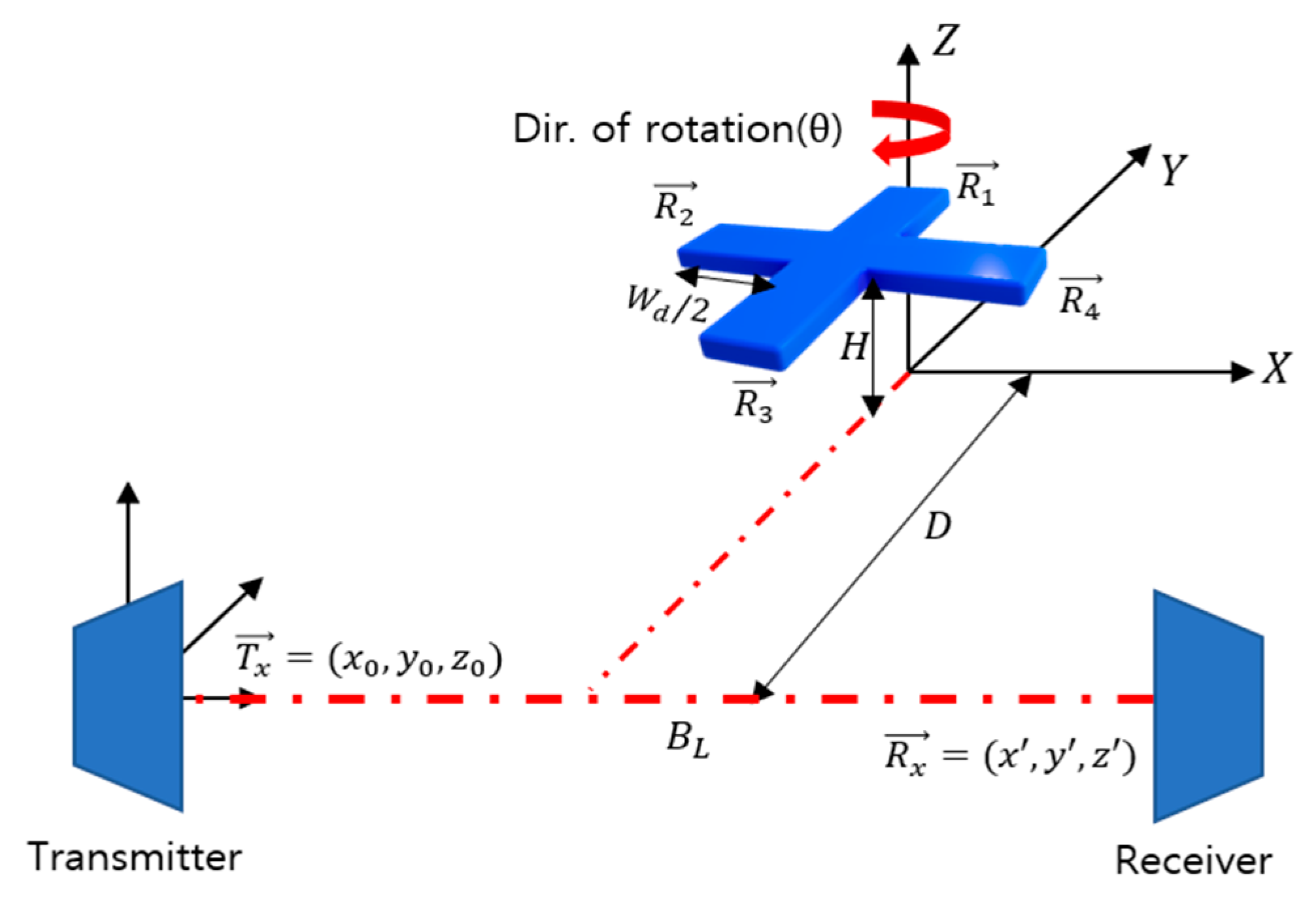
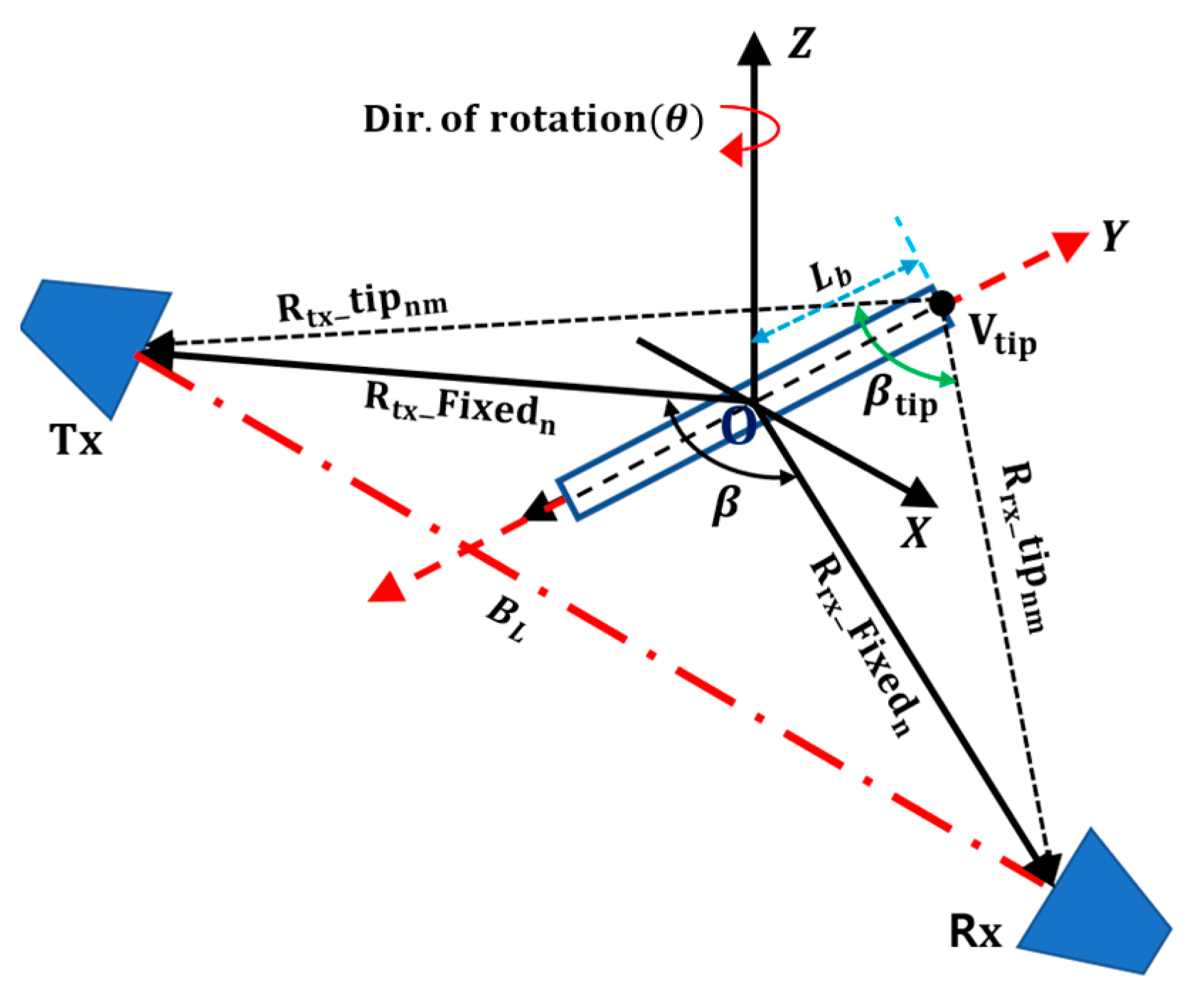
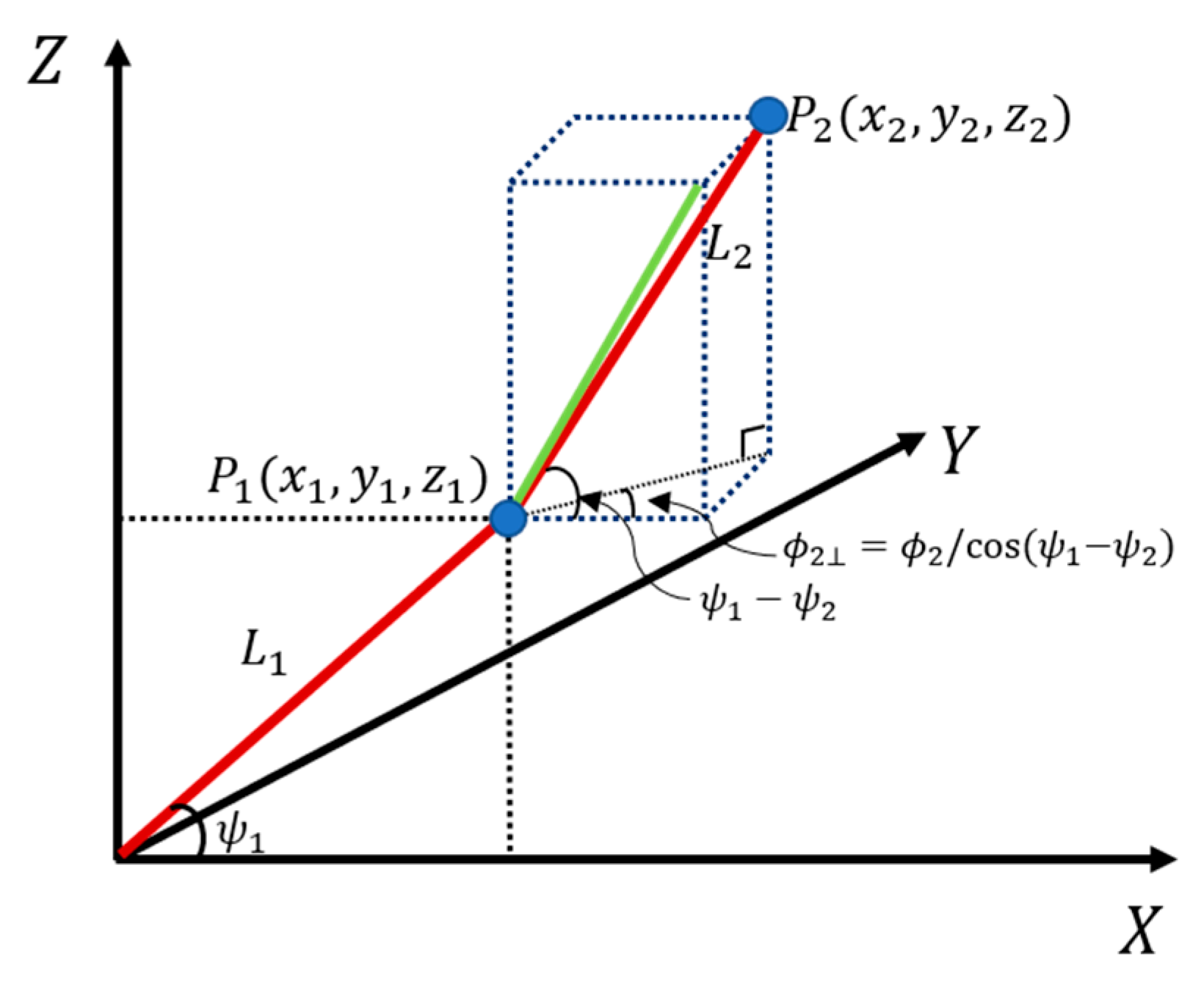
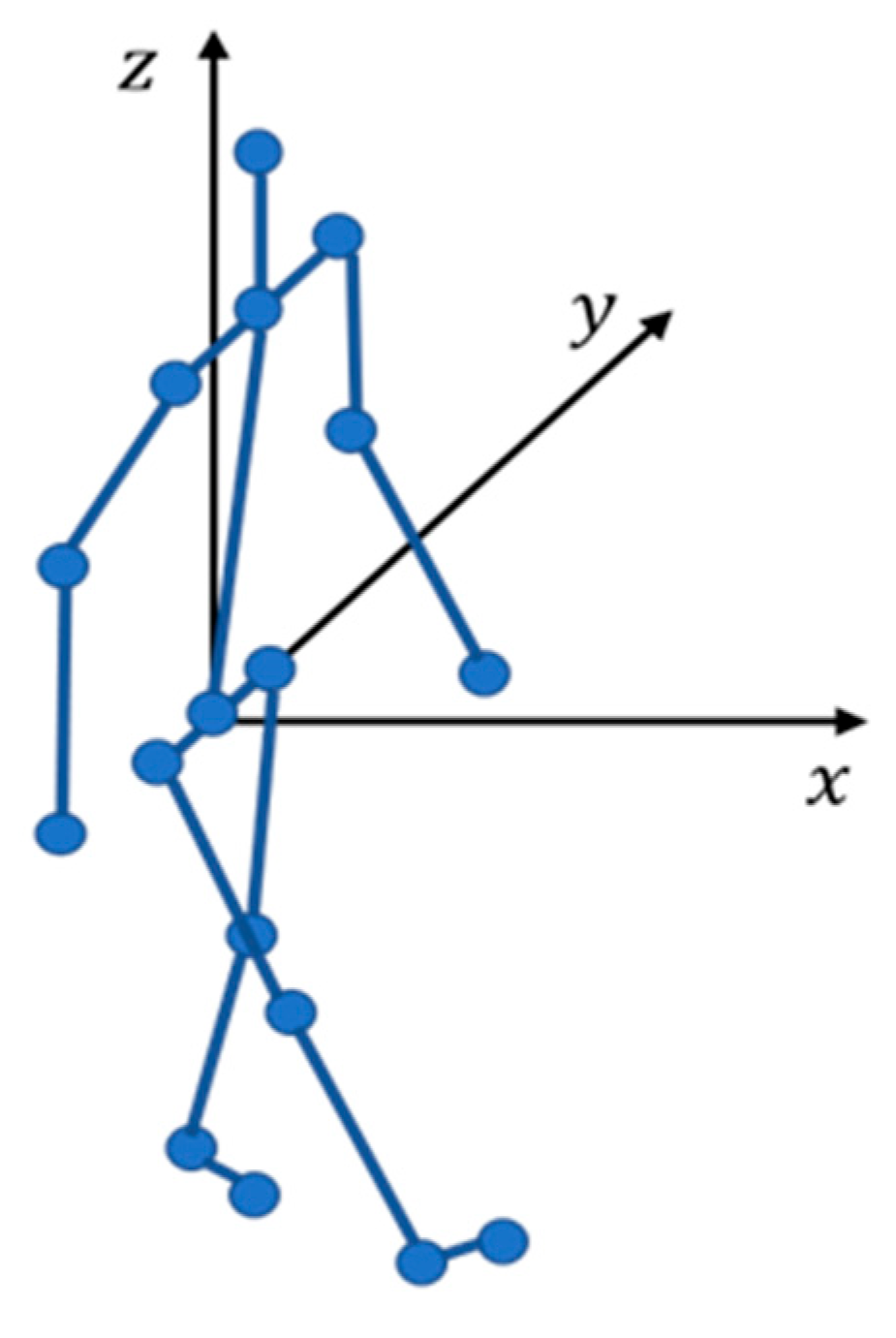

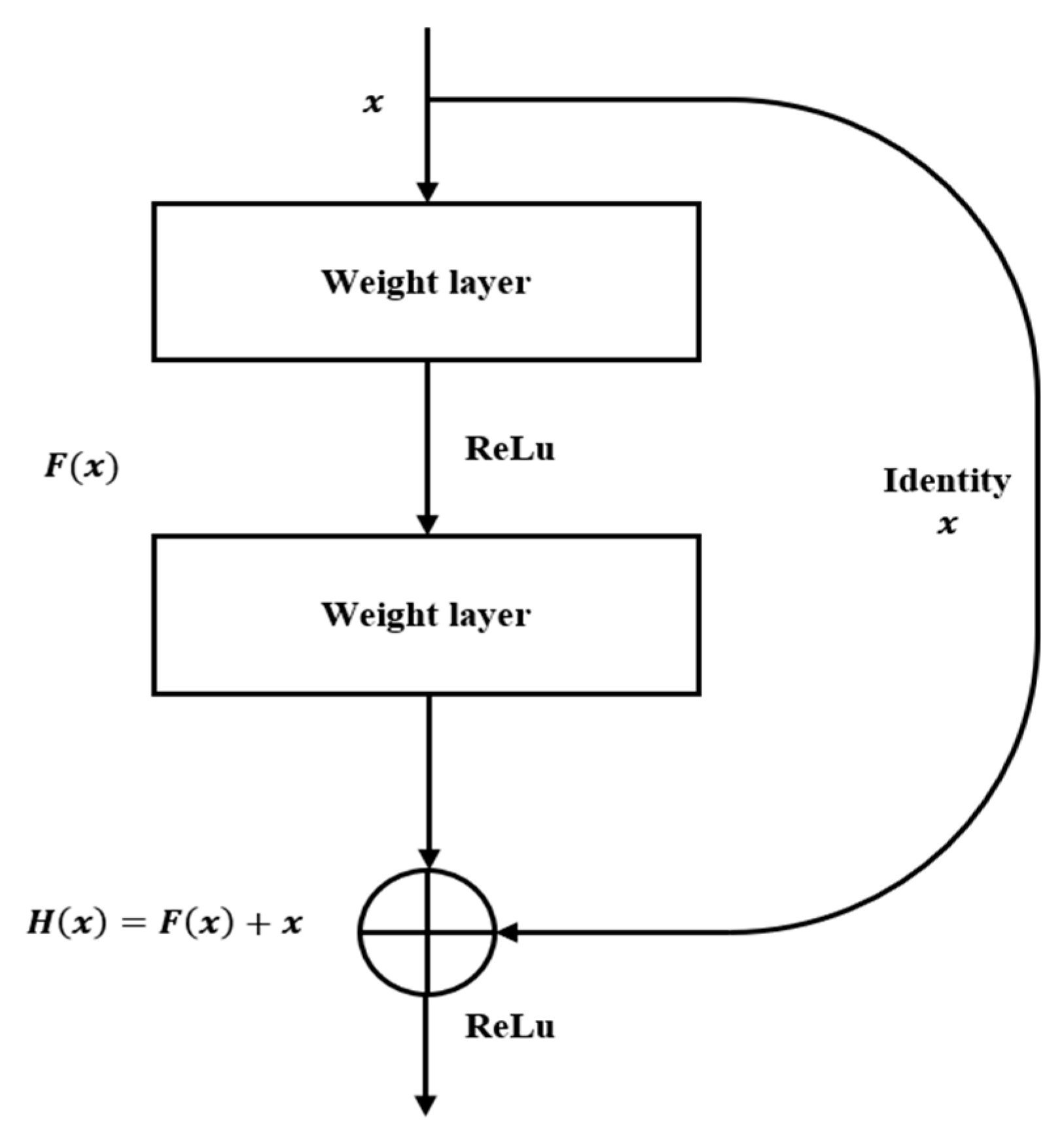

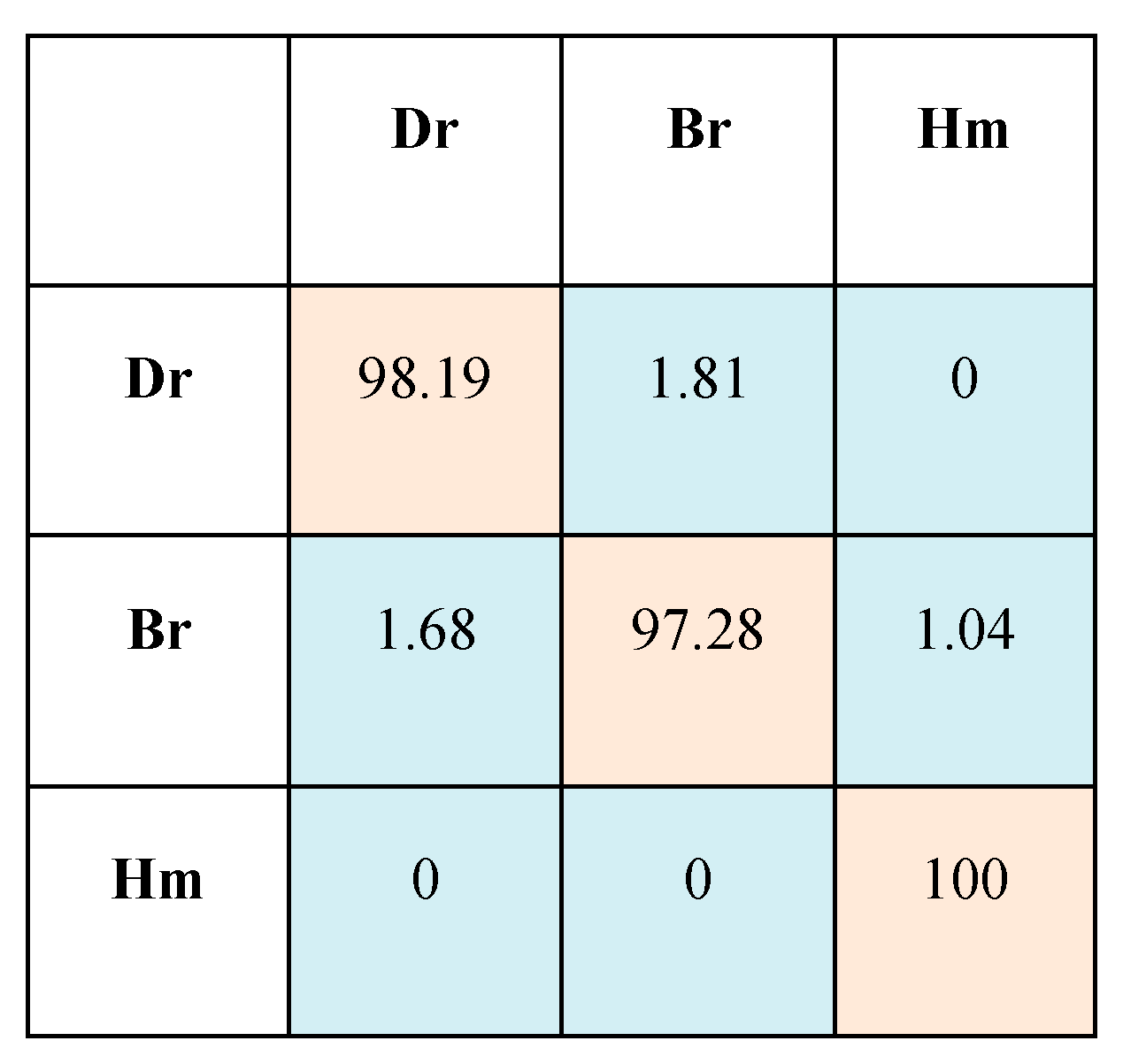
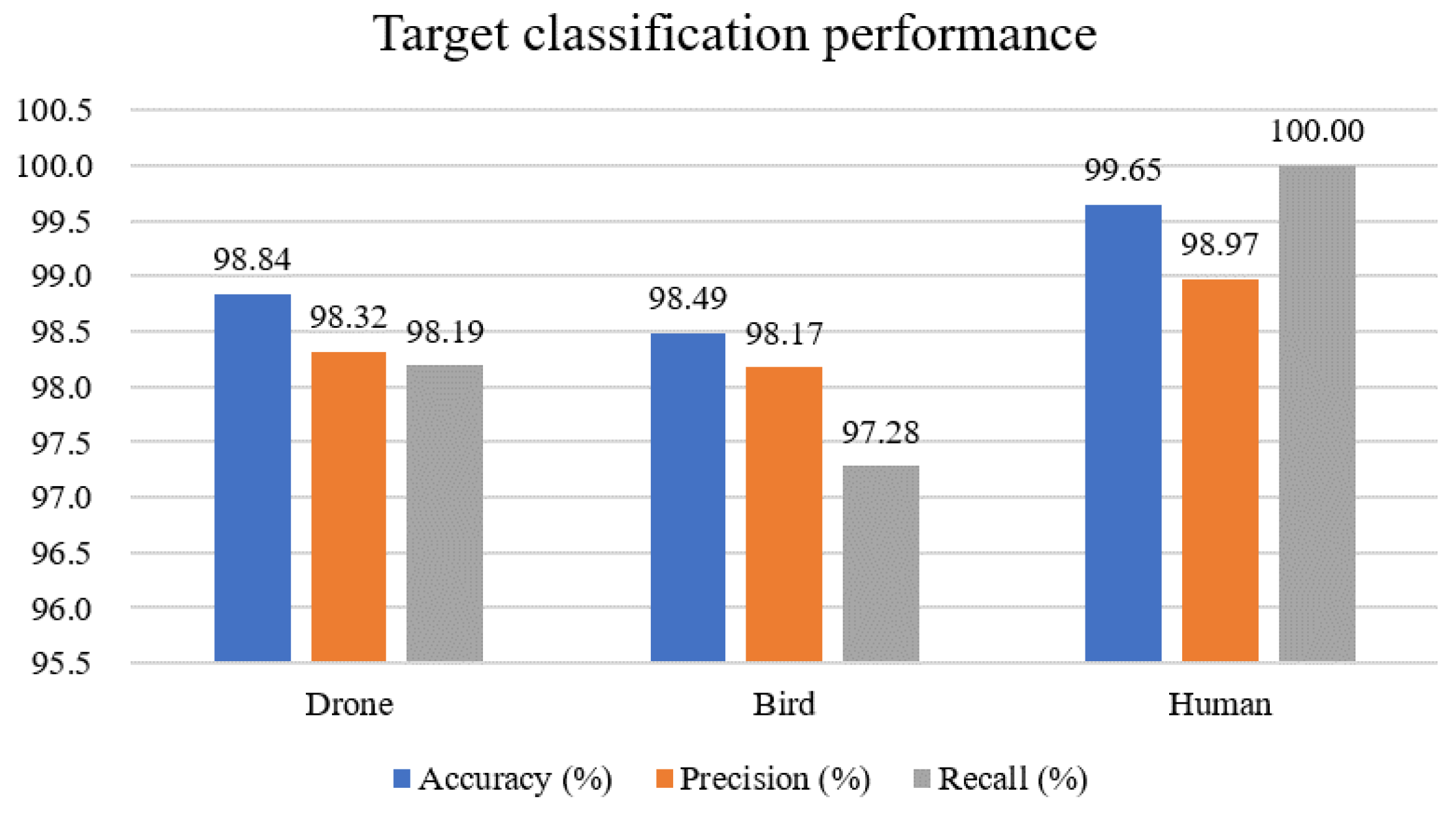
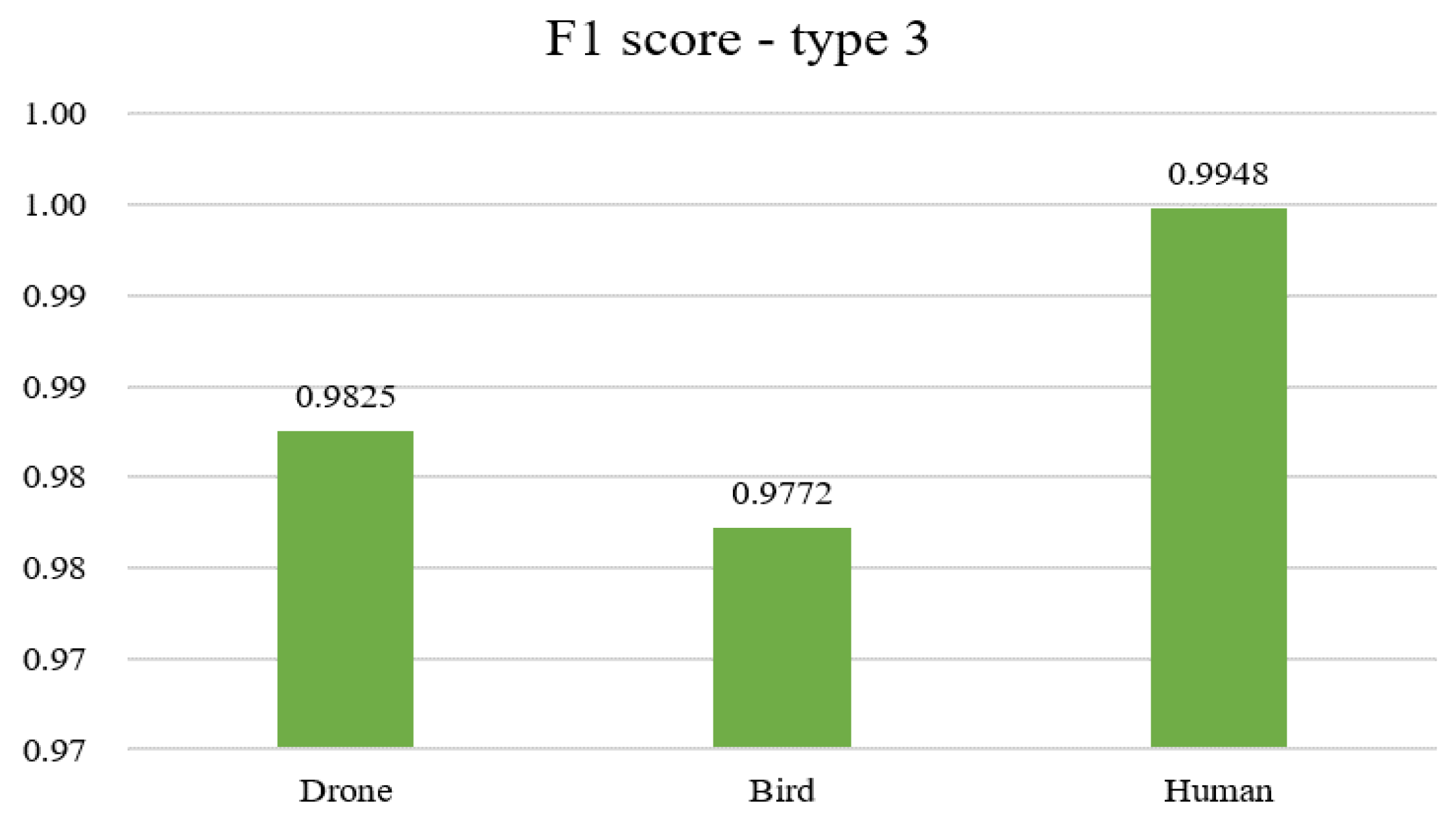
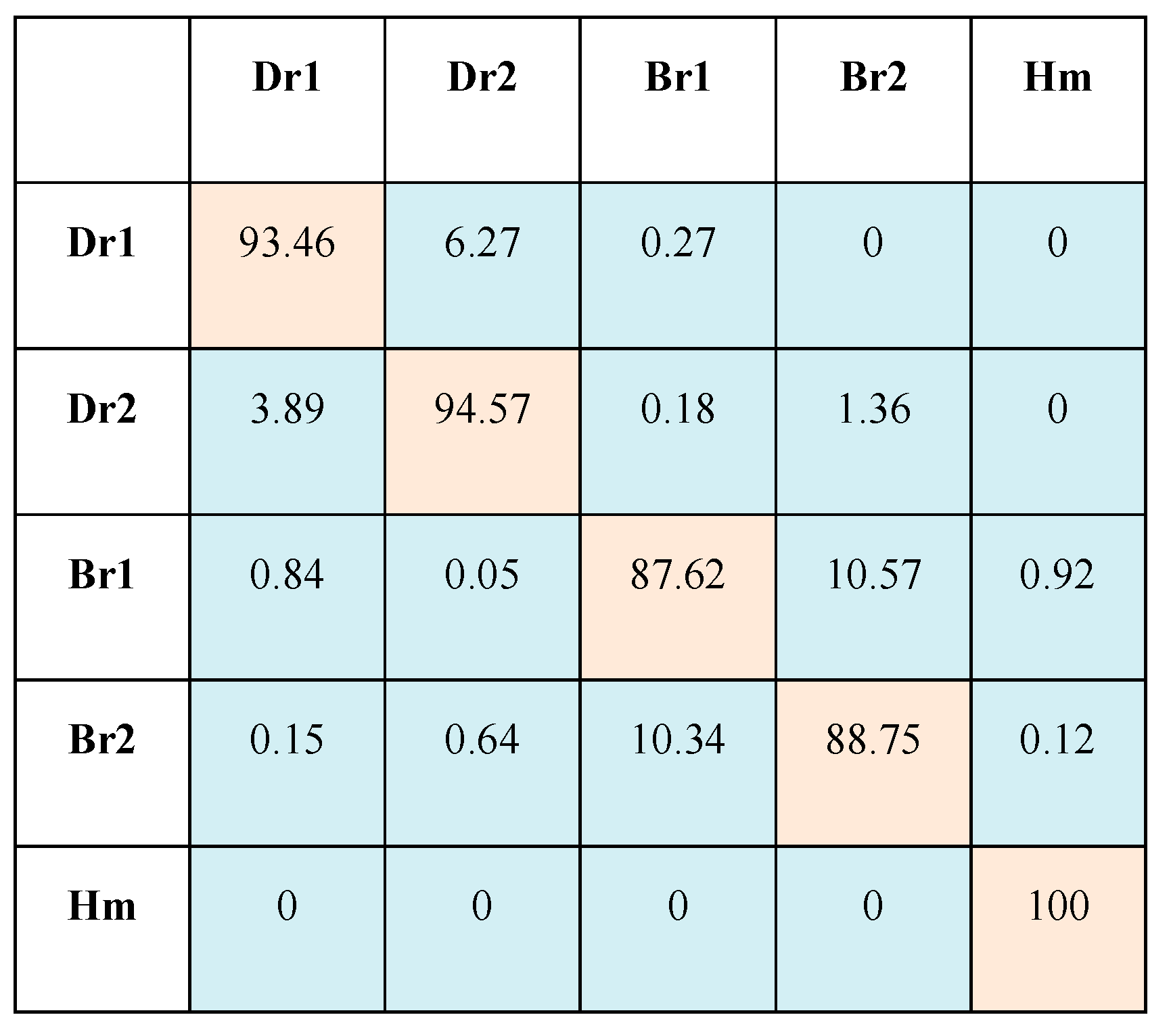
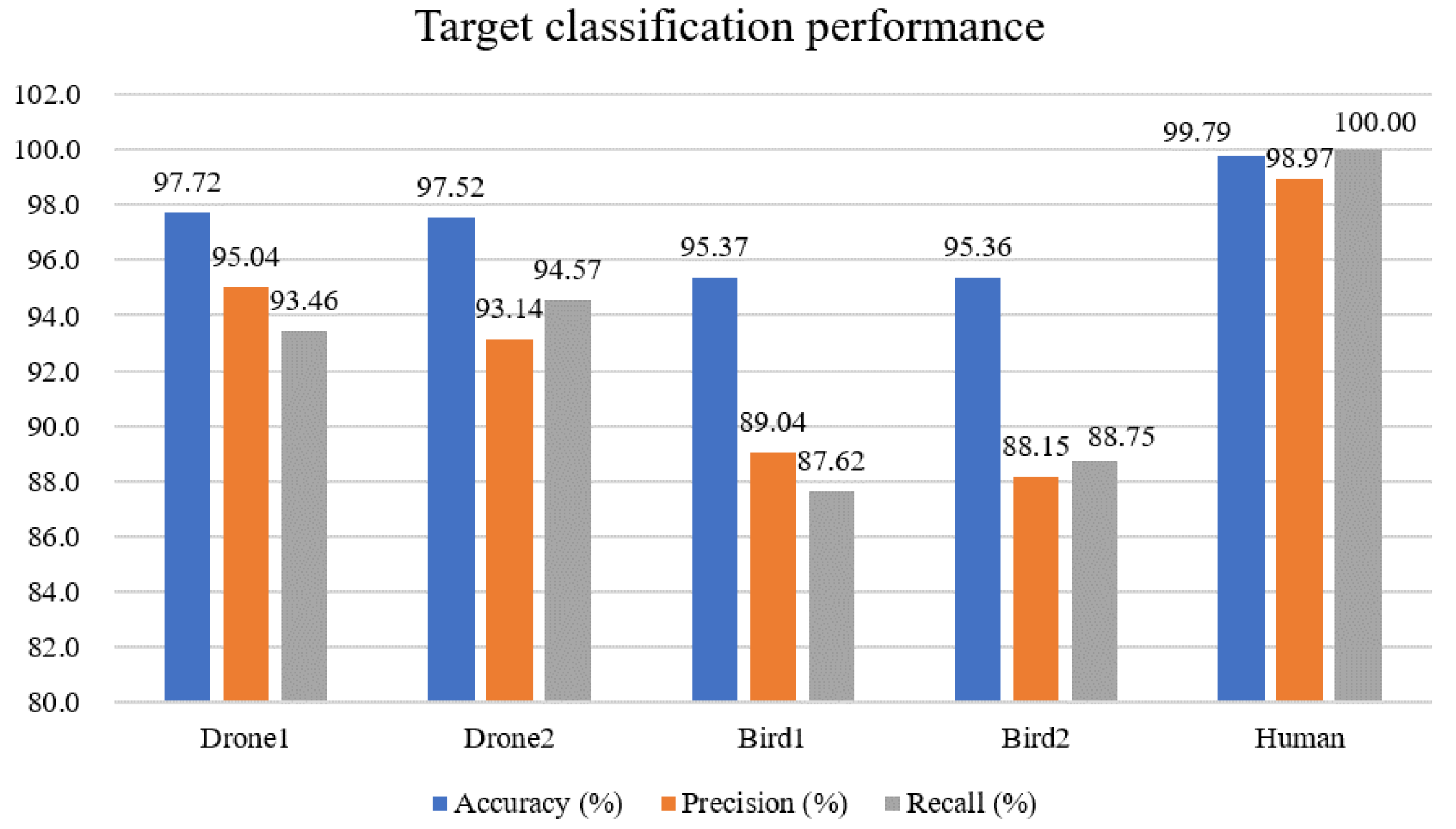
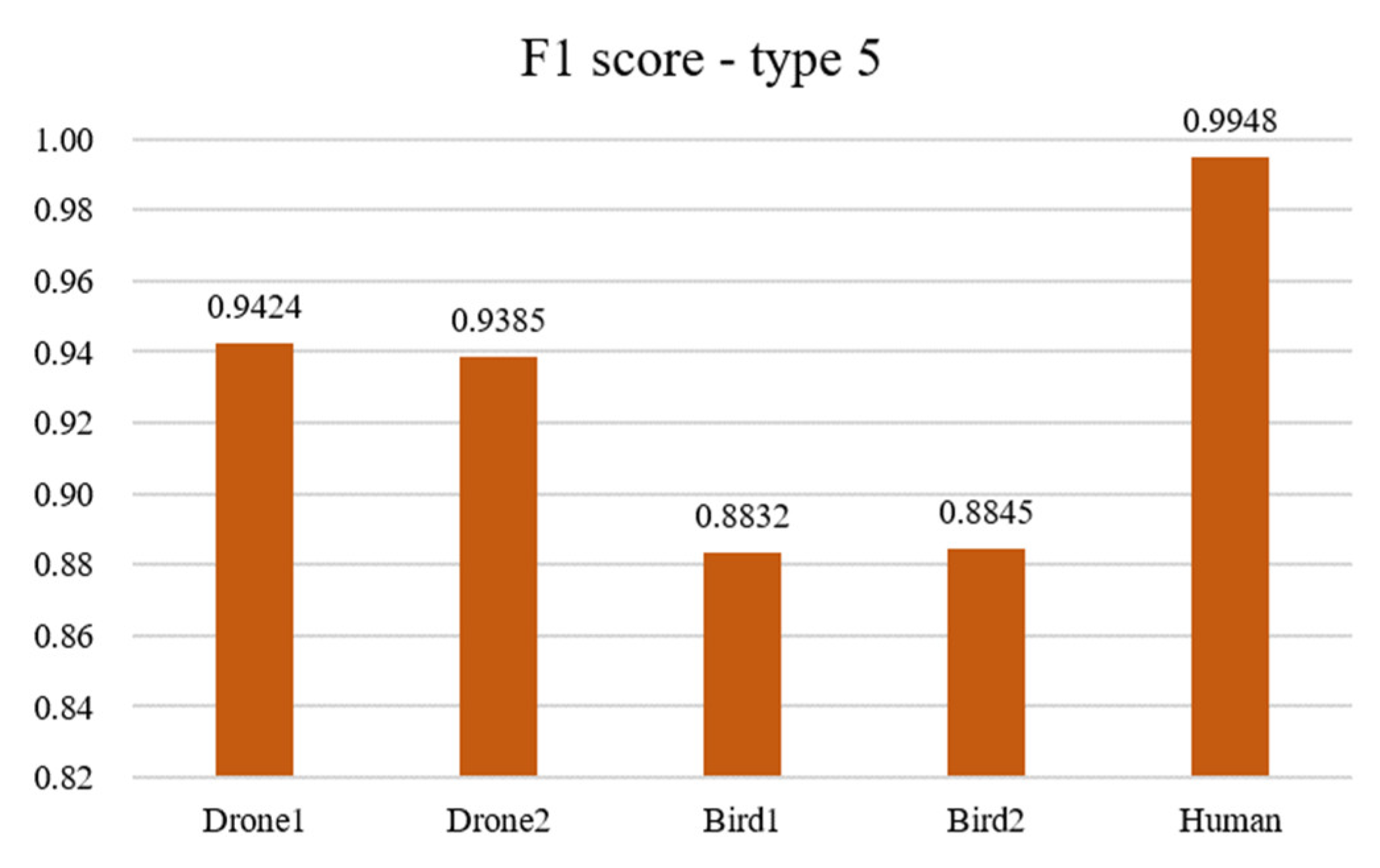
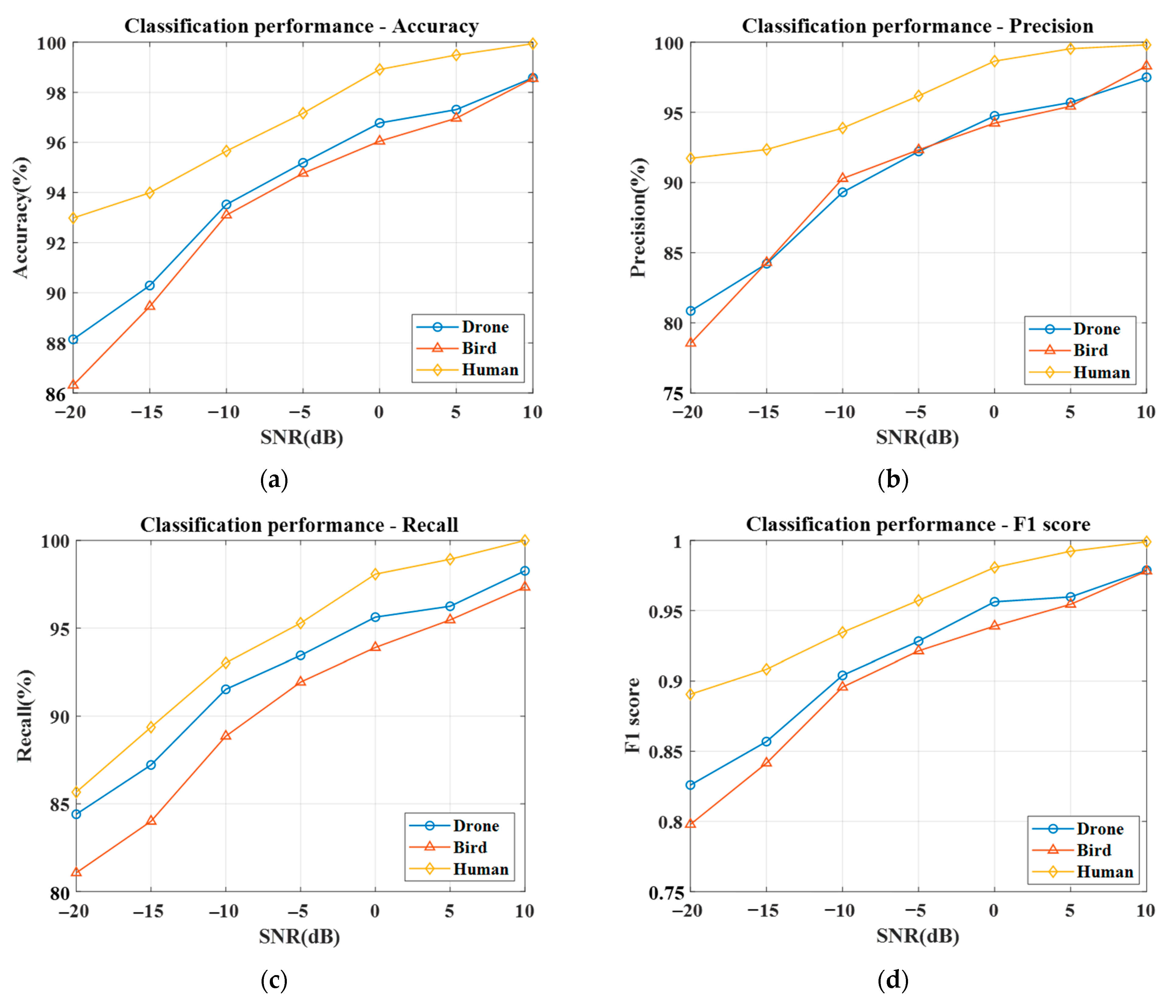
| Drone Type | Dimension (cm) | Range (m) |
|---|---|---|
| Bepop | 38 × 33 × 3.6 | 50 |
| AR | 61 × 61 × 12.7 | 50 |
| Bird Type | Flap Angle (rad) | Velocity (m/s) |
|---|---|---|
| Chukar | 2.5 | 1.2 |
| Pigeon | 1.57 | 1.5 |
| Classification Methods | Drones | Birds | Human | |
|---|---|---|---|---|
| ResNet using micro-Doppler image [16] | Accuracy (%) | 90.9 | 90.9 | 93.7 |
| Precision (%) | 85.3 | 87.7 | 90.9 | |
| Recall (%) | 87.8 | 84.6 | 90.9 | |
| F1-score | 0.8653 | 0.8612 | 0.909 | |
| ResNet using spectral kurtosis (w/o Embedding) [12] | Accuracy (%) | 95.7 | 95.8 | 97.9 |
| Precision (%) | 93.5 | 93.8 | 96.8 | |
| Recall (%) | 93.5 | 93.5 | 97.2 | |
| F1-score | 0.935 | 0.9365 | 0.97 | |
| ResNet using spectral kurtosis (with Embedding) | Accuracy (%) | 98.8 | 98.5 | 99.7 |
| Precision (%) | 98.3 | 98.2 | 99.0 | |
| Recall (%) | 98.19 | 97.28 | 100 | |
| F1-score | 0.9825 | 0.9772 | 0.9948 | |
Disclaimer/Publisher’s Note: The statements, opinions and data contained in all publications are solely those of the individual author(s) and contributor(s) and not of MDPI and/or the editor(s). MDPI and/or the editor(s) disclaim responsibility for any injury to people or property resulting from any ideas, methods, instructions or products referred to in the content. |
© 2024 by the authors. Licensee MDPI, Basel, Switzerland. This article is an open access article distributed under the terms and conditions of the Creative Commons Attribution (CC BY) license (https://creativecommons.org/licenses/by/4.0/).
Share and Cite
Kim, J.-H.; Kwon, S.-Y.; Kim, H.-N. Spectral-Kurtosis and Image-Embedding Approach for Target Classification in Micro-Doppler Signatures. Electronics 2024, 13, 376. https://doi.org/10.3390/electronics13020376
Kim J-H, Kwon S-Y, Kim H-N. Spectral-Kurtosis and Image-Embedding Approach for Target Classification in Micro-Doppler Signatures. Electronics. 2024; 13(2):376. https://doi.org/10.3390/electronics13020376
Chicago/Turabian StyleKim, Ji-Hyeon, Soon-Young Kwon, and Hyoung-Nam Kim. 2024. "Spectral-Kurtosis and Image-Embedding Approach for Target Classification in Micro-Doppler Signatures" Electronics 13, no. 2: 376. https://doi.org/10.3390/electronics13020376
APA StyleKim, J.-H., Kwon, S.-Y., & Kim, H.-N. (2024). Spectral-Kurtosis and Image-Embedding Approach for Target Classification in Micro-Doppler Signatures. Electronics, 13(2), 376. https://doi.org/10.3390/electronics13020376






